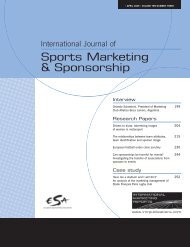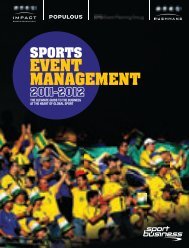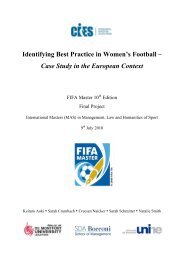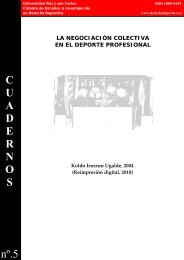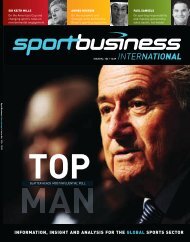4 - FIFA/CIES International University Network
4 - FIFA/CIES International University Network
4 - FIFA/CIES International University Network
Create successful ePaper yourself
Turn your PDF publications into a flip-book with our unique Google optimized e-Paper software.
DEAL OF<br />
THE MONTH<br />
KEVIN McCULLAGH<br />
Senior Reporter, TV Sports Markets<br />
The Nimbus Communications agency,<br />
holder of the worldwide media rights for<br />
international cricket in India, agreed a<br />
carriage deal with US cable-television<br />
operator Comcast for new cricket<br />
channel Neo Cricket.<br />
PAY-TV MUST UP ITS GAME<br />
Christian Seifert, chief executive of the Deutsche Fussball Liga, told<br />
TV Sports Markets in an exclusive interview in July that Germany’s weak<br />
pay-television market was the biggest challenge facing the Bundesliga.<br />
GERMANY, Europe’s largest television market,<br />
must develop a genuine pay-television culture<br />
if its top football league, the Bundesliga, is to<br />
match the broadcast revenue-generating power<br />
of Europe’s other top leagues, the league said the<br />
week ending Friday July 2.<br />
The league will also need the national<br />
cartel authority, the Bundeskartellamt, to relax<br />
its restrictions on the league’s collective sale of<br />
rights, if it is to have a chance of realising its<br />
media value.<br />
Speaking exclusively to TV Sports Markets,<br />
Christian Seifert said that the weak German<br />
pay-television market was the single greatest<br />
challenge facing the league.<br />
“This is the biggest challenge - whether it<br />
will be possible to strengthen the pay-television<br />
culture. The growth rate on our international<br />
sales has been good, but this has not been<br />
reflected in our domestic sales,” he said.<br />
<strong>International</strong> sales for the present cycle will<br />
reach almost three times what was generated in<br />
the previous deal. Domestic broadcast fees, in<br />
contrast, rose less than two per cent - and the<br />
DFL won praise even for that.<br />
Seifert said the onus was on German paytelevision<br />
operators to create products that<br />
challenged the strong free-to-air operators in<br />
the market: “There is potential for growth for<br />
our broadcast revenues. But it is related to the<br />
ability of pay-television providers to address the<br />
German customer. Pay-television has a chance to<br />
grow as long as it offers a product which reflects<br />
the specific needs of the German market.”<br />
Pay-television penetration in Germany is at<br />
Christian Seifert - Getty Images Sport<br />
only 12 per cent, about a quarter of that in the<br />
UK and Italy and half that in Spain and France.<br />
That is partly a reflection of the strength of the<br />
German free-to-air market, which is a powerful<br />
brake on pay-television growth, but also on the<br />
past mistakes and failures of Germany’s leading<br />
pay-television broadcaster, Sky Deutschland,<br />
formerly Premiere. Losing the Bundesliga rights<br />
to cable operator Unity Media’s Arena operation<br />
in the 2006-07 season set back Sky’s growth by<br />
at least two years.<br />
The DFL is hoping for a more benign<br />
regulatory environment for the next round of<br />
sales. Last time it was forced to ditch a<br />
500 million per season, six-year deal with media<br />
mogul Leo Kirch that hinged on increasing the<br />
value of pay-television rights by pushing back<br />
the Saturday night free-to-air highlights from<br />
6.30pm to 10pm, similar to the English Premier<br />
League model. To the astonishment of competition<br />
lawyers, the cartel authority insisted on an early<br />
evening free-to-air highlights programme.<br />
“The last process was very much influenced<br />
by the fact that we had the obligation to show the<br />
free-to-air highlights programme before 8pm on<br />
Saturday”, said Seifert. “When it was clear that<br />
was fixed, there was only very limited competition<br />
on the most important live packages.”<br />
Seifert said that the league and its broadcasters<br />
were pleased with the new structure of Bundesliga<br />
coverage last season, the first of a new four-year<br />
cycle. New live match and highlights programme<br />
slots helped drive up revenues and have delivered<br />
good increases in total audiences for the<br />
Bundesliga on both pay-television and free-to-air.<br />
A cricket channel in the US? Where is<br />
the demand?<br />
The channel will cater mostly for the<br />
South-Asian expatriate population in the<br />
US. It will be included in pay-television<br />
channel bundles created specifically for<br />
this demographic. Nimbus is aiming to<br />
start with 200,000 to 250,000 subscribers,<br />
rising to around 500,000 after one year.<br />
There is demand for the channel from<br />
US pay-television companies - as well as<br />
the deal with Comcast, deals are in the<br />
pipeline with Time Warner, Cabelvision,<br />
Cox, Echostar and DirecTV.<br />
Why launch a channel? Why not just sell<br />
the rights to a US-based broadcaster?<br />
Nimbus sold the rights to satellite<br />
broadcaster Echostar in the previous fouryear<br />
cycle, 2006 to 2010, in a deal worth<br />
over $50 million. However demand for<br />
cricket content from US broadcasters has<br />
flat-lined since then. Competition between<br />
Echostar and DirecTV for control of the<br />
South Asian ex-pat market has faded, and<br />
the value of the rights was undermined by<br />
rampant internet piracy. Nimbus thinks<br />
that launching Neo Cricket will be more<br />
lucrative than selling the rights, but it<br />
arguably had no other option.<br />
Nimbus is also considering launching<br />
a UK channel, targeting around 200,000<br />
subscribers to South-Asian pay-television<br />
channel bouquets there. As in the US,<br />
Nimbus may be able to earn more from a<br />
channel than from selling the rights.<br />
What are the US channel’s prospects<br />
for success?<br />
Nimbus’s subscriber targets are<br />
considered ambitious. Echostar showed<br />
the Indian cricket rights on South Asian<br />
sports channel Zee Sports America last<br />
time. The channel attracted around 100,000<br />
subscribers. Potential barriers to growth<br />
include competition from Willow TV, which<br />
has the rights for World Cup cricket and<br />
the Indian Premier League. Also, Nimbus<br />
only has non-exclusive broadband rights<br />
for Indian cricket, meaning the Board of<br />
Control for Cricket in India could also sell<br />
these to another US broadcaster, or even<br />
exploit them itself.<br />
SportBusiness <strong>International</strong> • No.160 • 09.10 21





